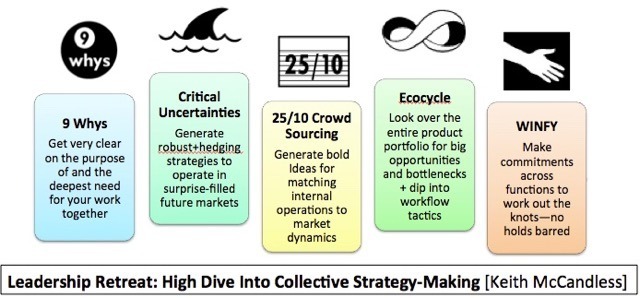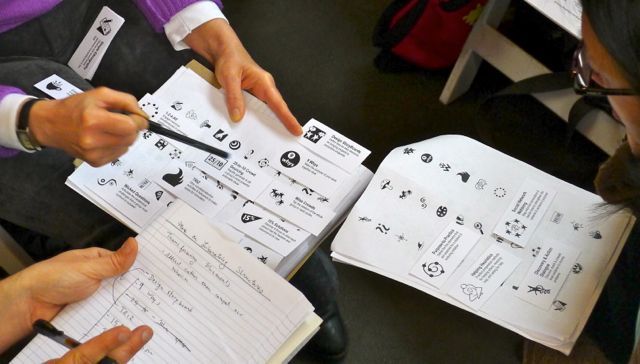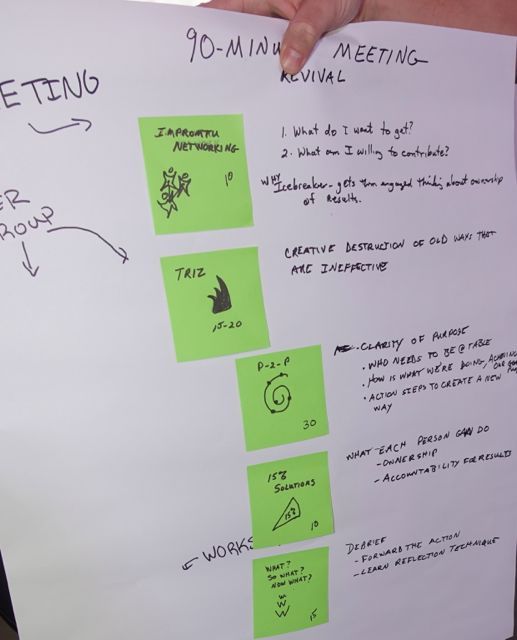Sample Strings
From the thousands of combinations that thirty-three different structures make possible, we selected a few examples that will quickly give you a good idea of what you can construct yourself.
One Liberating Structure can transform a meeting. A powerful string can draw out much-better-than-expected results in a way that forever shifts the pattern of working together. In Rhapsody for Strings (PDF), accomplished maestros share and rhapsodize about their favorites. Here are the topics and themes addressed.
 One of nine strings illustrated in "Rhapsody for Strings." A wide array of topics and challenges are addressed. PDF here.
One of nine strings illustrated in "Rhapsody for Strings." A wide array of topics and challenges are addressed. PDF here.
- Building Financial Literacy with High School Students [Greg Myers]
- Liberating Learning Together: Using LS in Our Work [Nancy White]
- Leadership Retreat: High Dive Into Collective Strategy-Making [Keith McCandless]
- Tap the Founder’s Story To Uplift Next Level Innovation [Liz Rykert]
- Management Meeting: In Charge But Not In Control [Neil McCarthy]
- Get Over Yourself, NOW! Prepare To Go Deeper with Your Customers [Fisher Qua]
- Cross-Sector Community Groups Catalyzing Learning + Action [Anna Jackson]
- Catalyzing Nursing Knowledge for BIG Data Science [Dan Pesut]
- Strategic Planning to Tactical Plans in Three Fractal Movements [Tim Jaasko-Fisher]
Rhapsody for Strings PDF file

More sample strings outlined below will get any number of participants started, whether a large group or one as small as two people. We grouped them into five broad scenarios. Don’t hesitate to make up your own pattern of strings!
Goal 1: Finding Everyday Solutions
Look for triggers such as these: meetings are rote or uninspiring, people spend more time presenting than doing, rigid practices get in the way, top-down initiatives have no buy-in, imported best practices are not welcome. Any of them is a clear signal that there is a need for changes such as stopping unproductive activities, tapping tacit know-how to stimulate new ideas, discovering local solutions, building trust, and coordinating action.
Sample strings
TRIZ + 1-2-4-All + 15% Solutions + Troika Consulting
Make space for new ideas with TRIZ by stopping unproductive activities or rigid behaviors. Invite everybody to generate new ideas with 1-2-4-All. Ask all participants to identify what they can do immediately, what their 15% Solutions is, and then invite them to help their peers expand and enhance their own 15 percent in a Troika Consulting session.
Nine Whys + 1-2-4-All + 15% Solutions + 25/10 Crowd Sourcing (for groups larger than fifteen)
Clarify purpose with Nine Whys. With 1-2-4-All, invite all participants to generate 15% Solutions that they can act on without additional resources, detailed planning, or special approvals. Then invite all participants to propose bold solutions that require more resources. With groups of more than fifteen people, sift the solutions with 25/10 Crowd Sourcing.
Drawing Together + 1-2-4-All + 15% Solutions + Troika Consulting
Invite everybody to access and reveal hidden insights and solutions to a shared challenge through nonverbal expression. Create shared images via Drawing Together. With 1-2-4-All, interpret the drawings and sift and sort emerging solutions and first steps. Ask all participants to identify what they can do immediately, “What is your 15% Solution?” Then invite them to help their peers expand and enhance their own 15 percent in a Troika Consulting session.
Users Experience Fishbowl + 1-2-4-All + Wicked Questions
To pave the way for others to learn and adapt, ask for a few volunteers to share in a Users Experience Fishbowl their experiences and behaviors while facing a complex challenge. With 1-2-4-All, invite everybody to generate Wicked Questions that reveal the paradoxical goals that the group must absolutely address with its next steps.

Goal 2: Noticing Patterns Together
Look for triggers such as these: group members are cynical, people no longer see opportunities for positive change, the group feels stuck in a rut, a surprising or shocking event has thrown off expectations or disturbed the market. Any of them is a signal that there is a need for changes such as finding new ways of understanding a complex challenge; expanding the boundaries for solutions; determining multiple actions by including many in finding and diagnosing patterns together; and clarifying requirements for system-wide coordination.
Sample strings
What, So What, Now What? + Appreciative Interviews + Min Specs
With What, So What, Now What? clarify the current reality (where the group is starting, really), what it means, and what actions this suggests. Uncover with Appreciative Interviews the patterns and conditions that made past successes possible. Reduce the list through Min Specs down to the absolute must dos and must not dos for moving forward successfully. Revisit the Now What? opportunities for action and identify those that meet the Min Specs.
Shift & Share + Wicked Questions + 1-2-4-All
Draw a wide variety of innovative activities out into the open with Shift & Share. Illuminate the narrow path to more success and novel mash-ups with Wicked Questions. Sort the follow-up activities or widen the path with 1-2-4-All.
Conversation Café + What, So What, Now What? + … Next string
Following a surprising or shocking development, engage everybody with a Conversation Café to reflect on and make sense of the new situation. Share the facts and insights to decide on the next steps with What, So What, Now What? Compose a string for making progress on the next steps.
Impromptu Networking + Generative Relationships + 1-2-4-All
Stimulate sharing, reflection, and a few new connections with Impromptu Networking. With Generative Relationships, jointly diagnose the interaction patterns that are inhibiting the group’s performance and identify what each person and formal leaders can do to remedy the situation. Use 1-2-4-All to generate next steps.
WINFY + What, So What, Now What? Debrief + Wise Crowds in Fishbowl
Use WINFY to invite participants to clarify their group’s strategic needs for working effectively with all other functions and to find out what support each group can or cannot expect to receive. Follow with each group doing a What, So What, Now What? Debrief to decide their Now What? End with all the groups’ spokespeople participating in a Wise Crowds consultation session to spark better relationships and coordination. Do the Wise Crowds in a Users Experience Fishbowl to get everybody on the same page.

Goal 3: Drawing Out Prototypes
Look for triggers such as these: current activities, services, or products are not performing well; creative individuals are frustrated or isolated; there are no clear paths for new ideas to attract investment; important client needs are ignored; patches to current offerings are expensive. Any of them is a signal that there is a need for changes such as: revealing and making explicit what is already working while inviting something new to emerge; drawing out successful “chunks” of what’s working and combining them in new ways; unleashing everyone in building prototypes; accelerating coordination, progress, and spread dramatically.
Sample strings
Appreciative Interviews + TRIZ + Ecocycle
With Appreciative Interviews, uncover the patterns and conditions that made past successes possible. Destroy barriers to innovation with TRIZ. Clarify the status of all products/services in the portfolio with the Ecocycle and identify opportunities for immediate action.
Users Experience Fishbowl + Simple Ethnography + Improv
Illuminate the limits of what is known about handling a challenge by asking the most knowledgeable people to share their experiences in a Users Experience Fishbowl. Use the information generated to guide the collection of observations through Simple Ethnography. Use this to create scenarios for Improv Prototyping.
Simple Ethnography + What, So What, Now What? Debrief + Design StoryBoard
Use observations gathered with Simple Ethnography to identify opportunities for prototyping. Review opportunities through the three steps of a What, So What, Now What? Debrief. Sketch out detailed plans for field testing and adaptations with Design StoryBoard.
DAD + 1-2-4-All + Design StoryBoard
Bring hidden solutions to chronic challenges into focus via a series of DADs. The dialogues will also invite peers to begin adapting successful behaviors in their own settings. Use 1-2-4-All to review individual and group successes in order to reveal what higher-level solutions emerge. Sketch out the path for determining how to coordinate across groups or units via a Design StoryBoard.

Goal 4: Unleashing Local Action
Look for triggers such as these: people are not taking risks; people are waiting for permission to act; layers of red tape stifle creativity; more time is spent presenting than acting; “analysis paralysis” has taken over. Any of them is a signal that there is a need for changes such as: unleashing purposeful action in large groups without detailed plans or elaborate budgeting; boosting freedom and responsibility with a minimal set of enabling constraints; improving coordination of diverse activities.
Sample strings
Open Space + Min Specs + 25/10 Crowd Sourcing
Unleash a wide array of local actions with Open Space. Then, within the well-defined boundaries of Min Specs, identify bolder initiatives with 25/10 Crowd Sourcing and invite volunteers to move them forward.
Nine Whys + Improv Prototyping + Design StoryBoard
Clarify with participants the deepest purpose of their work together with Nine Whys. Use Improv Prototyping to reveal what challenges emerge when addressing this larger purpose and what solutions emerge out of diverse participation. Put the pieces together in a Design StoryBoard for moving forward.
Critical Uncertainties + Wise Crowds + 15% Solutions
Generate robust stress-tested strategies for an unpredictable future with Critical Uncertainties. Use Wise Crowds and 15% Solutions to provide interdisciplinary advice to each individual about their implementation.

Goal 5: Spreading Innovation by Scaling Out and Up
Look for triggers such as these: innovations do not spread to other groups; specifications for adopting an innovation do not fit diverse operating realities; solutions at the local level do not scale up; formal efforts to standardize innovative practice are “gamed” or ignored by local units. Any of them is a signal that there is a need for changes such as: spreading ideas or innovations out across groups or units; scaling up from local application to regional, global, or policy levels; fueling movements and transformations across boundaries.
Sample strings
Nine Whys + Min Specs + Ecocycle + Panarchy
Clarify how your work is justified to the larger community (purpose) with Nine Whys and specify the must dos and must not dos with Min Specs. With the Ecocycle, clarify the status of your portfolio of activities and relationships at the level of your organization. Use Panarchy to clarify activities and relationships at all the other levels that affect your initiative and identify opportunities for actions.
Nine Whys + Social Network Webbing + 15% Solutions + Troika Consulting
Clarify purpose with Nine Whys. Then, with Social Network Webbing, identify all the individuals and groups that can be attracted to the work with formal or informal ties. With 15% Solutions, everybody decides what he or she can do immediately to strengthen and develop the network. Continue with Troika Consulting for each person to receive further advice on what to do and how.
Celebrity Interview + Min Specs + Ecocycle
Build deeper understanding and trust with formal leaders via a Celebrity Interview. Use Min Specs to identify the must dos and must not dos for spreading change. Draw the status of activities and relationships on the Ecocycle and identify opportunities for changes.
DAD + 1-2-4-All + Panarchy + Design StoryBoard
Use series of DADs to discover hidden solutions to chronic challenges and then 1-2-4-All for all participants to decide how to adapt successful behaviors to their local settings. Brainstorm how to insinuate the success at other levels with Panarchy. Sketch out pathways for coordinating up, down, and out via a Design StoryBoard.
Purpose-To-Practice + Drawing Together + Integrated~Autonomy
Create an organizational design based on shared ownership with Purpose-To-Practice. With Drawing Together, spark imaginative solutions to the challenges of integrated yet autonomous operations. Spell out the specifics of working across widely distributed sites with Integrated~Autonomy.
These few string examples illustrate how much you can accomplish in a short time—often less than one hour or ninety minutes—and how easy it will be for you to compose many others based on the specifics of your own challenges. Be prepared to be pleasantly surprised!
As a rule, we compose strings that include much more than we imagine can be accomplished in the time allotted. When we do not complete the entire string, there is a basis for planning next steps with the group. Be sure to keep records of your strings to share with others.
 Composing with design cards
Composing with design cards
 Simple and elegant string for a “Revival” meeting (created @ an immersion wksp in Seattle)
Simple and elegant string for a “Revival” meeting (created @ an immersion wksp in Seattle)
